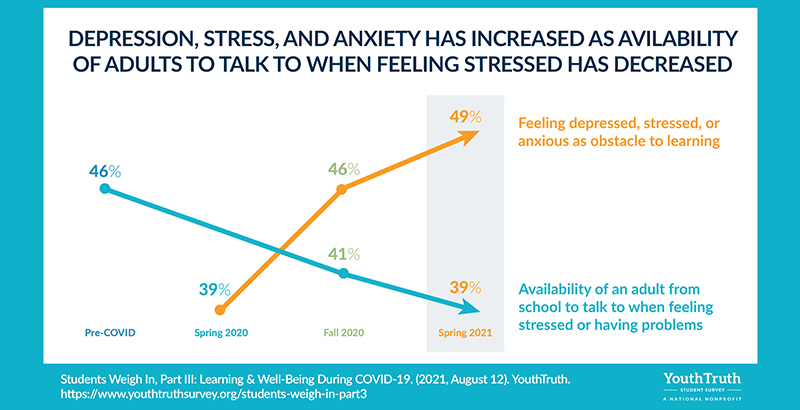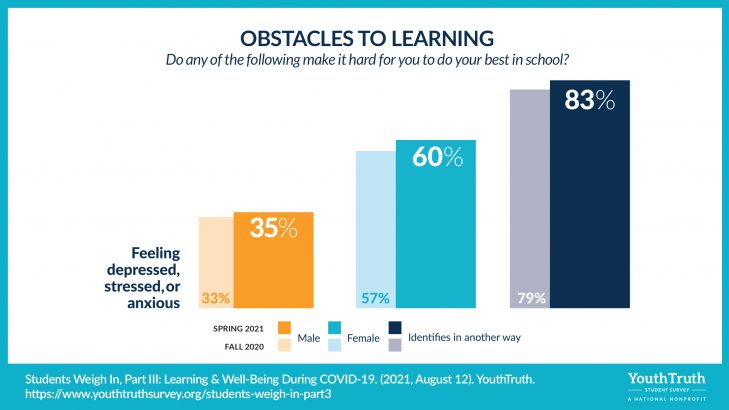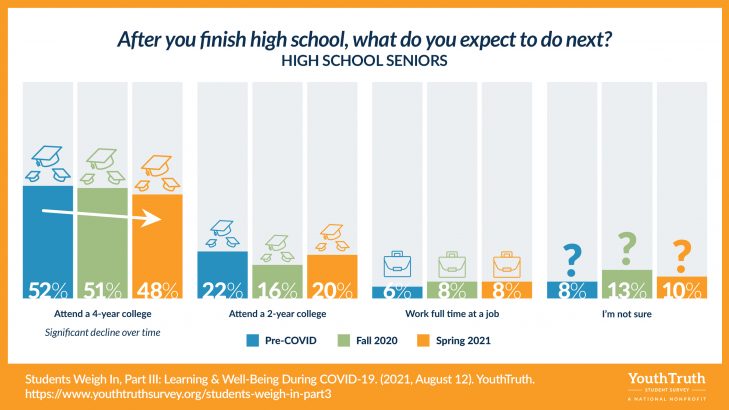Student Survey: Depression, Stress and Anxiety Leading Barriers to Learning as Access to Trusted Adults Drops

Education is at a Crossroads: Help Us Illuminate the Path Forward. Donate to The 74
Nearly half of American students with learning barriers cited increasing amounts of stress, depression and anxiety as the leading obstacle in the 2020-21 school year. At the same time, students say their access to a trusted adult to discuss that stress decreased, according to a new national survey.
In the third and final survey of young people during the pandemic by the national nonprofit YouthTruth, 49 percent of students talked about the detrimental effects of growing mental and emotional issues while just 39 percent said they had an adult at school to whom they could turn for support. The gap in access to social and emotional help has widened even from fall 2020 survey data, at the start of students’ first full pandemic school year.
YouthTruth Executive Director Jen Wilka said adult connection was actually at its highest at the start of emergency distance learning in spring 2020. Those interactions and energy, which students say is key to learning, are not as strong now a year and a half later, evidenced by the declining number of young people who say they have a supportive adult in their school orbit.
“Students really felt that increase in their teachers making an effort to sort of reach outside and beyond those virtual walls and understand what it is like,” Wilka said. “That has now waned, and is closer to normal, maybe a little bit higher than normal. We saw that really peak in spring 2020.”
One aspect of student-adult relationships in school that has improved over time is respect. Some 70 percent of students said they think adults treat youth with respect — up significantly from the 57 percent who believed that pre-pandemic.
A narrative animation compiles student write-in responses on stress, anxiety, and depression and how it affected their learning in 2020-21. (YouthTruth)
YouthTruth, which solicits student, family, and educator feedback, analyzed data from 206,950 third- through 12th-grade students across 19 states and 585 urban, suburban and rural schools. Open-ended and choice responses were solicited via anonymous 15-minute surveys from January through May 2021.
Previous pandemic-era surveys were conducted in 2020 by YouthTruth from May through June (20,000 students) and October through December (85,170 students). Mental health concerns have consistently been a barrier to learning, and high school seniors’ plans post-graduation continue to be affected by the pandemic. Students have been vocal about the importance of building relationships with their teachers, and their sense of belonging within their school community peaked in fall 2020.
Twenty-one percent of those most recently surveyed attend high-poverty schools, similar to the national average of 25 percent, and students’ racial identities mirror national averages.
For students of all gender identities, depression, stress, and anxiety has become more prevalent as a barrier to learning since fall 2020. For female- and non-binary identifying students, the rates are much higher, 60 and 83 percent, respectively.
Youth cite overwhelming workloads with assignments that lack relevance to their daily life and futures, according to write-in responses and qualitative analysis.
“School restricts me from being content with who I am,” one high school upperclassman shared. “We need to radically change the education system, it’s way overdue for that and it needs to right now. I cannot get out of bed anymore. I hate school more than how I used to. I’m mentally strained because of distance learning […] However, an English assignment and 11 other assignments are due by 11:59pm tonight because grades are so important – more important than surviving and finding new healthy coping mechanisms after all.”
Education leaders across the country are seeking ways to ameliorate growing concerns for students’ emotional and social well-being; a number of states plan to utilize American Rescue Plan funds to bolster mental health access.
In the North Clackamas School District, serving the greater Portland, Oregon area, social and mental health services were established pre-COVID yet leaders saw emotional needs grow during the pandemic. In response to the changing ways students needed access to adults and sought connection, the district partnered with providers and nonprofits to offer telehealth services, devices, and hotspots to youth and their families districtwide.
Through the pandemic, the district sought to make “sure that we had established pathways that were normalized, made very typical and open for families to access a mental health therapist,” Dr. Shelly Reggiani, the district’s director of equity and instruction, told The 74 during a YouthTruth press call last week.
In sharing other ways to remove learning barriers and improve engagement, youth said they’d like to see more real-world topics, like applying for higher education, financial aid, and jobs and learning personal finance.
Survey results show that fewer seniors surveyed this spring will head to four-year institutions this fall, a trend also reflected by declining enrollment rates, which saw the worst single-year decline since 2011. And though more will enroll in two-year colleges than in fall 2020 — about 20 percent of those surveyed — the proportion hasn’t yet rebounded to pre-pandemic levels.
Qualitative survey data revealed some of the barriers that persist for high schoolers looking to access higher education. Students recognized “the need for social capital (like from a teacher or sibling) as part of college access,” the confusing nature of the application process, which is typically formally taught during the school day, and felt that finding information and choosing to apply came “too late,” YouthTruth researchers told The 74.
“The school is pushing students to go to a four-year college and for most students they don’t want to go to a four-year college because they don’t want to go into debt,” one student said.
“Give us Pathways for the Future,” one of four video animations depicting trends from 480,000 open-ended responses and reflections on the 2020-21 academic year. (YouthTruth)
“They’re really searching for meaning in learning, and that’s an opportunity for us as educators to connect learning, and real life, and relevance to help address students’ needs here,” Sonya Heisters, YouthTruth’s deputy director, said.
Other notable findings
- Secondary school students’ perceptions of learning and belonging returned to pre-pandemic levels
- Many Spanish-speaking students detailed how language barriers became an additional obstacle to their learning during virtual and hybrid environments, and 21 percent of Hispanic/Latino students cited lack of teacher support as an obstacle to learning compared to just 14 percent of other students.
- Providing inclusive curricula, adopting anti-racist policies, and treating students fairly are common recommendations found among data from 5,000 Black / African-American students.
- Many students enjoyed paper-free learning, and hope to maintain access to online materials with the return to in-person school
- Black/African-American and Hispanic/Latino students report feeling unsafe in school at higher rates than their peers, at 11 and 16 percent respectively vs. 9 percent for non-Black, non-Hispanic students.
- 65 percent of students report that their teachers give extra help when needed, but this is more common among students who receive high academic grades
Disclosure: The Bill & Melinda Gates Foundation provides financial support to YouthTruth and The 74.
Get stories like these delivered straight to your inbox. Sign up for The 74 Newsletter

;)


